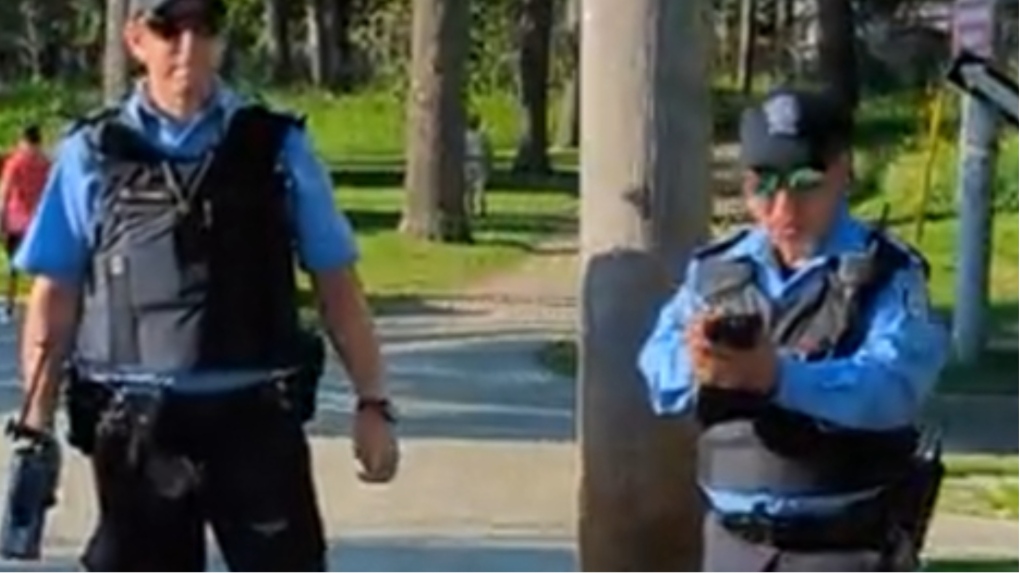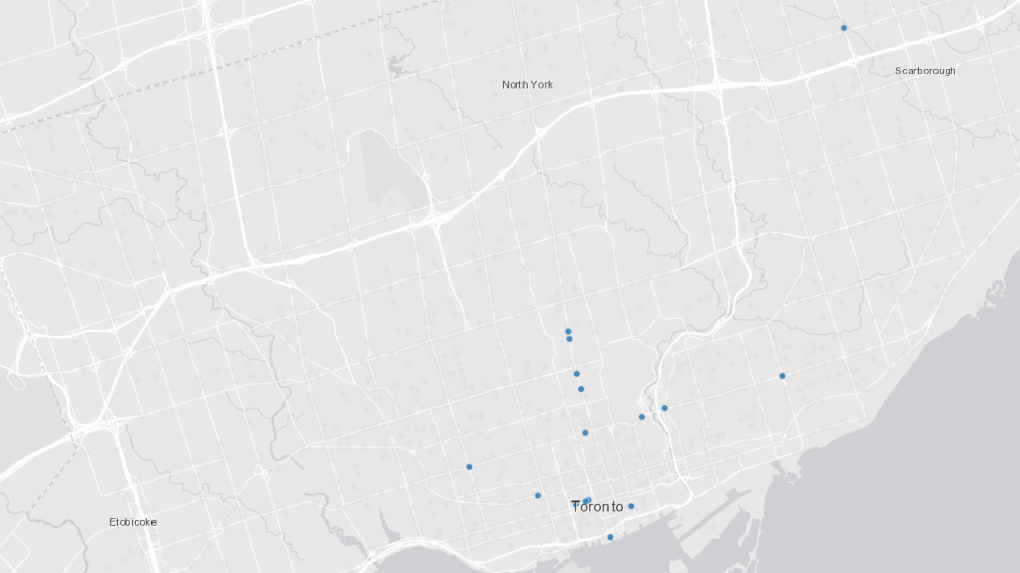Ticketing cyclists for speeding in popular Toronto park 'waste of resources,' advocates say
 A lawyer and advocate says Toronto police are wasting resources by having officers stake out intersections at High Park to catch speeding cyclists. (Twitter / @TheBikingLawyer)
A lawyer and advocate says Toronto police are wasting resources by having officers stake out intersections at High Park to catch speeding cyclists. (Twitter / @TheBikingLawyer)
A lawyer and advocate says Toronto police are wasting resources by having officers stake out intersections at High Park to catch speeding cyclists.
It’s not uncommon to see cyclists racing through city parks, either for leisure, exercise or transportation purposes. But Toronto officials say this has led to numerous complaints from residents.
In July 2021, the city said more than 60 tickets were handed out to cyclists and drivers respectively for speeding and running through stop signs at High Park. According to David Shellnutt, managing partner of the Biking Lawyer LLP, officers are back at the park again this summer.
On Tuesday, Shellnutt received a call from a BIPOC cyclist who became concerned after seeing two police officers at a stop sign pointing an item in their direction. The item turned out to be a radar gun, but Shellnutt said the cyclist was still understandably intimidated.
“They told me that they were there in the park because 11 division sergeants sent them there and that they had been getting tons of requests about dangerous cyclists hitting pedestrians,” Shellnutt said. “I told them that simply wasn't true based on our own data.”
According to publicly available Toronto police data, between 2006 and 2020, there have been 16 incidents of cyclists striking pedestrians in which a serious or fatal injury was reported. None of those incidents were in High Park.
 Toronto police data shows the number of pedestrians seriously or fatally injured in collisions involving cyclists between 2006 and 2020.
Toronto police data shows the number of pedestrians seriously or fatally injured in collisions involving cyclists between 2006 and 2020.
Toronto police have said that both members of 11 Division and the City of Toronto have received complaints regarding cyclists and vehicles travelling at a high rate of speed in High Park.
In a statement to CTV News Toronto, a spokesperson said that police and bylaw officers are placing themselves at stop signs within the park to educate drivers or riders about proper speed behaviours.
“This has served as an educational piece for cyclists being advised of the (Highway Traffic Act) infractions they could face as well as the inherent dangers of going too fast," Const. Tina Trepanier said.
“Toronto Police Auxiliary Officers have also been detailed to patrol the park as well. This has been welcomed by the local community as well those visiting the park.”
No information was available on whether or not any tickets have been issued to cyclists at the park so far this year.
Shellnutt says that most incidents involving cyclists occur outside of the park, and often lead to injuries for the cyclists themselves.
He said that last year a friend of his got a $120 ticket for speeding and therefore decided to use the bike lanes outside of the park instead.
“(He) got hit by a right-(turning) car, broke his clavicle and the driver got less of a ticket for speeding,” he said.
Shellnutt adds that assigning officers to monitor roads within parks is a “waste of resources” considering there is no data to back up the actions.
“There's actually no factual basis for why they would spend city resources doing that. As someone who cycles in the city every day, I go out, I see a car parked in a bike lane or I almost get hit … nowhere are their police stationed to ticket drivers.”
Instead, Shellnutt says the city should be looking at ways to deal with residents’ concerns without involving police. One suggestion he had was to have dedicated days or times in which cyclists could use the roadways exclusively.
“It's a public space. We all should be able to use it.”
- Download our app to get local alerts to your device
- Get the latest local updates right to your inbox
Gord Perks, the city councillor for Parkdale-High Park, agrees with this statement and has been leading the city's “High Park Movement Strategy,” which has a goal to improve mobility within the park in a way that promotes safety and accessibility.
“The way we use High Park has been changing because we instituted the car free weekends, which continue, and during the pandemic people were going to High Park who hadn't gone before or wasn't part of their regular routine and it became part of their regular routine and they really liked it.”
“My view is that you handle conflicts between pedestrians and cyclists and cars by design, not just sending enforcement.”
Some of his solutions include designated car-free days, permanent closure of one or more vehicle entrances, enhanced transit services, speed limit reductions, pedestrian-only areas, separated bike lanes and road reconfiguration.
Consultations are set to begin on the strategy in the coming weeks, Perks said, and implementation of the new design would take place in 2023 with the new Toronto City Council.
In the meantime, Perks says that city council does not dictate where police set up speed enforcement campaigns. Both he and the city’s park department have received multiple complaints from residents concerned about vehicles—both cars and bikes—speeding in the area, and he is aware of some instances in which cyclists have collided with pedestrians, but none in which a serious injury has been reported.
He also noted that last year, 830 tickets were handed out to drivers navigating the streets around the park.
“While those couple of hours when (police) were in the park drew the eye, the fact of the matter is that they're routinely, almost every day, catching cars driving too fast outside the park,” Perks said. “I think we need to keep those two things in relative perspective.”
CTVNews.ca Top Stories

Budget 2024 'likely to be the worst' in decades, former BoC governor says
Without having seen it, former Bank of Canada governor David Dodge believes that Tuesday's 2024 federal budget from Deputy Prime Minister and Finance Minister Chrystia Freeland is 'likely to be the worst budget' in decades.
What's at stake for Canada after Iran's unprecedented attack on Israel
Following the Iranian missile and drone strikes against Israel over the weekend, Canada should take the threat of Iran and potential escalation of the conflict seriously, one global affairs analyst says.
Former B.C. school trustee's 'strip-tease artist' remark was defamatory, judge rules
A controversial former school trustee from B.C.'s Fraser Valley who described a political rival as a "strip-tease artist" during an election campaign has been ordered to pay her $45,000 for defamation.
'A sense of urgency': Sask. man accused of abducting daughter calls himself to the stand during trial
Michael Gordon Jackson, the man on trial after being charged with contravention of a custody order for allegedly abducting his daughter in late 2021 to prevent her from getting a COVID-19 vaccine, called himself to the stand Monday.
Kingston, Ont.'s Aaliyah Edwards drafted into WNBA
After four years at the University of Connecticut, Edwards was selected sixth overall by the Washington Mystics in the WNBA draft Monday night.
NASA confirms mystery object that crashed through roof of Florida home came from space station
NASA confirmed Monday that a mystery object that crashed through the roof of a Florida home last month was a chunk of space junk from equipment discarded at the International Space Station.
A knife attack in Australia against a bishop and a priest is being treated as terrorism, police say
Horrified worshippers watched online and in person as a bishop was stabbed at the altar during a church service in Sydney on Sunday evening.
Body of 14-year-old boy pulled from Lake Ontario, police say he drowned while swimming
The body of a 14-year-old boy has been pulled from Lake Ontario after police say he drowned while swimming near Ashbridges Bay Park on Sunday night.
'Rust' armourer gets 18 months in prison for fatal shooting by Alec Baldwin on set
A movie weapons supervisor was sentenced to 18 months in prison in the fatal shooting of a cinematographer by Alec Baldwin on the set of 'Rust.'
































